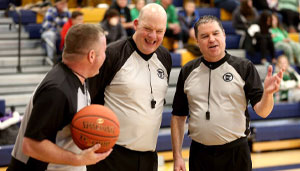Returning Athletes to Their Sport: A Brief Overview of the Process
By Alyssa Babcock on October 21, 2016 Coaches PrintRecovering from any injury is a process. When helping an athlete return to sport participation, it is important to remember that there are two major aspects involved: physical recovery and mental recovery. They are both equally important and present their own challenges to the athlete, coach and health-care team involved. Each injury and athlete is different. This makes it vital to recognize that adaptability and flexibility in approaches to recovery will likely be necessary to precipitate a successful return to athletics. Some injuries are physically significant and will require a long rehabilitation before the athlete is back to full strength, while others may be more mentally taxing and will require building up confidence before the athlete is ready to return to play. Essentially, each injury will require its own plan and have a separate timeline that will likely change throughout the process. It is important to remind the athlete that their recovery cannot be compared to anyone else’s because it is always different. Each athlete will have their own challenges, be it mental or physical, and it is crucial to be able to adapt and help the athlete overcome their injury.
The physical approach to injury recovery is based mainly off the area injured, severity and type of injury. The athletic trainer researches to determine a good starting point for rehabilitation. The first 24 to 72 hours focus on decreasing pain and swelling before starting any kind of rehabilitation program. This typically includes the implementation of rest, ice, compression and elevation – commonly called RICE. These tools will aid in the recovery and help comfort the athlete’s physical pain. In addition to RICE, including range of motion (ROM) exercises is also important. These exercises will aid in reducing swelling and stiffness, which can speed up the physical recovery for the athlete. For example, a popular ROM exercise for an ankle sprain is having the athlete place their injured ankle in an ice bucket and write the ABCs as best they can for around 10 minutes. Once an injury has reached the point where swelling and pain are under control, a more intensive rehabilitation is started. This typically begins with more ROM and non-weight bearing strength exercises, slowly progresses to weight bearing strength exercises, plyometrics, sports specific exercises, and then finally sport activities and practices. One thing to keep in mind is that setbacks tend to happen with almost every injury. This is very normal but will require adjustments to exercises and expectations to find a better balance for the athlete. Once they have completed the rehabilitation and are back to full sport participation, a maintenance routine of exercises and taping or bracing is recommended to keep up their strength and reduce the chance of further injury.
Probably the most challenging part of any recovery is the mental aspect of the injury. This is generally because there is no scientific approach that tells athletes step-by-step how to fully mentally recover. It is critical that the athletic trainer and coaches assess the mental state, personality and drive of the athlete. Knowing them on a personal level will significantly aid in the recovery process because their program can be tailored individually. For instance, some athletes want to know every detail of what they will encounter and might not need much encouragement, while others will need more guidance and constant reassurance. Knowing the athlete is key to helping them recover mentally. Once they have started rehabilitation, it is important to keep them motivated mentally to help them push through setbacks, pain, frustration, disappointment, and a myriad of other emotions common in the recovery process. To do this, the athletic trainer and coach will use different tools to encourage the athlete through their recovery.
- Knowledge is Power: One of the first things to do when approaching an athlete with their program is to ensure that they understand what is wrong with them physically. One way athletic trainers will do this is through visual aids like anatomy charts or drawings. When combining that with a verbal description of the injuries and potential rehabilitation time, the athlete can better prepare for the coming weeks and challenges. In addition to knowing the physicality of the injury, it is helpful that the athlete understands that setbacks are common and completely normal. Even athletes that do everything right may still have setbacks, and this can be very frustrating to them, especially if they were not prepared for the possibility.
- Recognizing Teamwork: This is probably one of the most important aspects to an athlete’s recovery. Being able to work together as a team (athletic trainer, athlete, coach, strength coach, etc.) is vital to a good rehabilitation. Without full cooperation and combined effort between the team, a successful recovery can be more challenging. Starting off the recovery with everyone on the same page and open to discussion throughout the process will provide significant support to the athlete’s recovery.
- Set Goals: One of the most common approaches to any problem or long term process is goal setting. Rehabilitation can be made more effective when the athlete has both short and long term goals to approach. Short term goals are a great way to provide the athlete with a sense of accomplishment from the beginning of rehabilitation. Daily and weekly goals can provide a strong focus for the athlete and reduce the feelings of frustration that they are not making as fast a recovery as they would like. Long term goals can be set by month or even be end goals for when the athlete is fully recovered. Again, these goals will help the athlete stay focused and perceive each short-term goal as a stepping stone to accomplishing the “big picture.”
- Visualization and Imagery: Some athletes respond really well to this tool and others do not. Trial and error is a part of rehabilitation, so be open to the fact that the athlete might not respond to this particular strategy. Visualization and imagery can help the athlete maintain focus and motivation by having them imagine where they want to be in a week, a month, next season, etc. It gives them an outlet to dream big and also feel like they are still a part of the game. Some examples of this can be having the athlete visualize different successes or skills like making five free throws, successfully completing five defensive plays, etc.
- Keep It Fun: Making sure that the athlete is not bored with their rehab is important to maintaining motivation. The athletic trainer can make games out of the different exercises, use treats/prizes as incentive to completing their daily program, and incorporate a teammate or coach to make them feel like they are still part of the team. These are all ways to successfully integrate the athlete into their normal routine and decrease the monotony of the daily exercises and treatments.
- Building Confidence: Confidence is another major factor that needs attention throughout the process. This is often done by starting the athlete on sports-centered exercises, making sure they are still involved in team activities, and including the coach in the program and daily activities so they can help encourage and motivate the athlete as well. All of these together will help the athlete regain their confidence in their ability to participate in the sport without fear of injury.
The take home point is recognizing that any injury has both a physical and mental aspect that contributes to the athlete’s recovery. Remember, each athlete and injury is different and each recovery will present new challenges. Working together as a team will help alleviate stressors and provide support to the athlete throughout the process. With this knowledge comes the power to help an athlete successfully complete their rehabilitation program and reintegrate into their team with full confidence in their ability to play like they did before their injury.
Alyssa Babcock
Most Recent Articles
- nfhs news NFHS Learning Center Delivers 25 Millionth Course
- Track & Field/Cross Country article Effective Communication with Athletes and Coaches
- nfhs news Player Equipment Changes Highlight 2025 High School Football Rules Revisions
- Player Equipment Changes Highlight 2025 High School Football Rules Revisions
- nfhs news Judgment Call on Second Contact Eliminated in High School Volleyball






